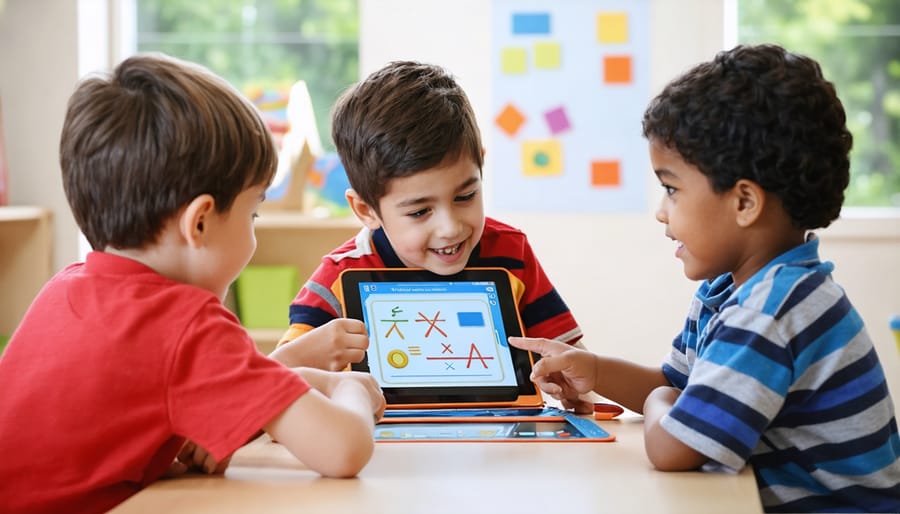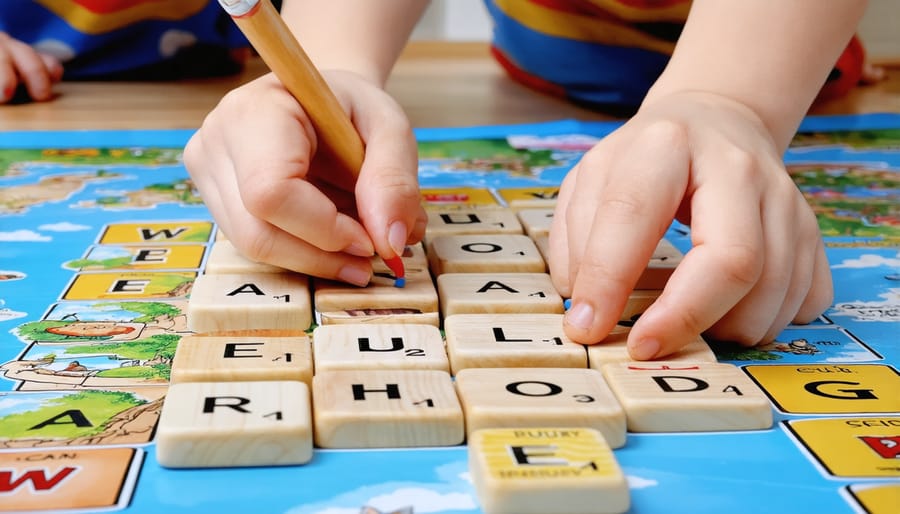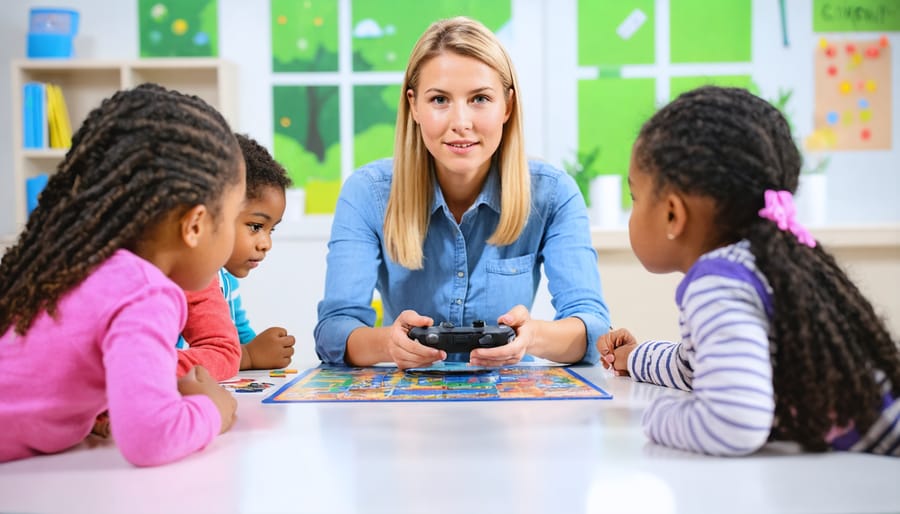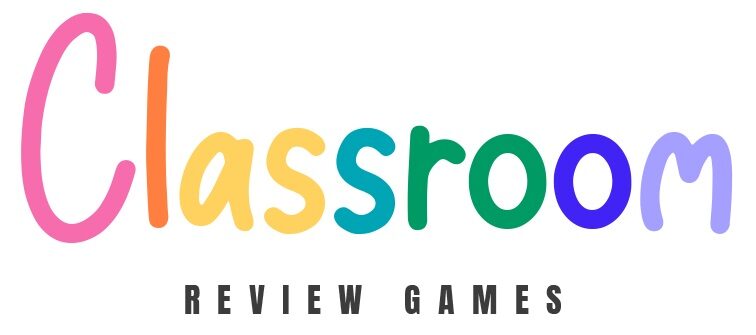Make Learning Magic: Educational Games That 7-Year-Olds Actually Love
Transform your classroom into a learning playground with educational games that perfectly match your 7-year-olds’ developmental stage and curriculum goals. At this pivotal age, students rapidly develop critical thinking skills, reading fluency, and mathematical understanding – making games an incredibly powerful teaching tool. Interactive learning activities like number-based board games, word-building challenges, and digital problem-solving adventures not only reinforce key concepts but also foster collaboration and engagement naturally.
Choose games that combine fun with specific learning objectives – whether it’s practicing multiplication tables through dice games, building vocabulary through interactive storytelling, or developing spatial awareness through pattern-matching activities. The best educational games for this age group incorporate movement, friendly competition, and immediate feedback while maintaining the perfect balance between challenge and achievement. By integrating these purposeful play opportunities into your daily lessons, you’ll create an energetic learning environment where students eagerly participate and retain information more effectively.
What Makes a Great Educational Game for 7-Year-Olds?
Age-Appropriate Learning Goals
At age 7, children are entering an exciting phase of cognitive and social development. They’re typically ready to tackle basic multiplication, more complex reading comprehension, and critical thinking challenges. Most seven-year-olds can focus for 15-20 minutes on a single task and are eager to demonstrate their growing independence.
Key learning objectives for this age group include:
– Reading fluently and understanding story elements
– Adding and subtracting two-digit numbers
– Recognizing patterns and basic geometric shapes
– Developing stronger hand-eye coordination
– Building vocabulary and spelling skills
– Understanding cause and effect relationships
– Practicing social skills through group activities
When selecting educational games, look for those that encourage problem-solving while maintaining engagement. Seven-year-olds respond well to positive reinforcement and enjoy games that offer clear goals with achievable challenges. They’re also beginning to understand rules better, making this an ideal age for introducing strategy-based learning games that require planning and decision-making skills.
Engagement Factors
Seven-year-olds thrive on recognition and rewards, making it essential to incorporate achievement systems into educational games. Colorful animations, cheerful sound effects, and virtual badges can transform simple learning tasks into exciting adventures. These young learners are also naturally competitive, so incorporating friendly challenges and leaderboards can boost their motivation.
Interactive elements like drag-and-drop features, clickable objects, and mini-games keep their attention focused. Short, achievable goals work better than lengthy tasks, as children this age need frequent wins to maintain enthusiasm. Character customization and creative freedom are powerful motivators – letting students design their own avatar or learning space increases their investment in the game.
Stories and narratives woven into educational content create emotional connections, while progressive difficulty levels ensure they stay challenged without feeling overwhelmed. Remember to include opportunities for both independent play and collaborative activities, as social interaction remains a key engagement factor at this age.

Interactive Math Games That Work
Number Sense Games
Number sense activities are crucial for building a strong mathematical foundation, and there are plenty of engaging math games for students that make learning fun! Start with “Number Bond Buddies,” where kids pair up and use manipulatives to find different ways to make the same number. “Roll and Add” uses dice to practice addition, while “Shop and Count” lets students set up a pretend store to work with money and basic operations.
For a more active approach, try “Hop the Number Line” where students physically jump forward or backward to solve addition and subtraction problems. “Pattern Partners” helps kids recognize number sequences through clapping, stepping, or using colorful objects. These games can be easily modified to match different skill levels and learning styles.
Keep sessions short (10-15 minutes) and rotate between activities to maintain engagement. Use simple household items or classroom materials, and don’t forget to celebrate progress with small rewards or achievement charts!
Problem-Solving Adventures
Math becomes an exciting adventure with games that challenge young minds while keeping them engaged. Number sequencing puzzles, pattern recognition activities, and basic addition/subtraction games are perfect for 7-year-olds who are developing their mathematical thinking skills.
Try “Math Monster Munch,” where students solve simple equations to feed friendly monsters, or “Shape Detective,” which encourages spatial reasoning through interactive puzzles. These games naturally blend fun with fundamental math concepts.
For hands-on learners, set up a classroom store where students practice counting money and making change. Digital options like “Number Path” allow children to create their own math challenges while learning number relationships.
Keep the excitement high with “Math Safari,” where students count animals, sort them by size, and solve word problems in a vibrant jungle setting. Remember to rotate games regularly to maintain interest and gradually increase difficulty as students master concepts.
Incorporate team challenges where students work together to solve math puzzles, fostering both problem-solving skills and collaboration. These activities help build confidence while making mathematical thinking a natural part of their daily routine.
Language and Reading Game Success Stories
Vocabulary Builders
Building vocabulary can be a blast with interactive vocabulary review games designed for seven-year-olds! Word Bingo is a classroom favorite where students match vocabulary words to pictures or definitions, keeping them engaged while expanding their word bank. Create word-matching memory cards using seasonal themes or current lesson topics – kids love flipping cards to find pairs while learning new terms.
Hangman with a twist works wonderfully too! Instead of random words, use vocabulary from your current reading assignments or science units. Add picture clues to help visual learners connect words with their meanings. The classic Word Chain game, where each player must say a word beginning with the last letter of the previous word, helps kids think quickly and build their vocabulary naturally.
For tech-savvy options, try digital word scrambles or picture-word matching apps that let students progress at their own pace. Remember to celebrate success with small rewards or classroom recognition to keep motivation high!

Reading Comprehension Games
Reading comprehension games are fantastic tools for helping 7-year-olds develop their understanding of written text while having fun. Story dice are a creative way to encourage students to build narratives – simply roll the dice and let children create stories using the pictures they see. The popular “Reading Race” game gets kids moving as they read short passages and race to answer comprehension questions on task cards placed around the classroom.
Another engaging activity is “Character Hot Seat,” where students take turns pretending to be characters from a story while classmates ask them questions. This helps develop deeper understanding of character motivations and story elements. “Picture Perfect Sequence” cards allow children to arrange story events in order, strengthening their grasp of narrative structure.
For a tech-friendly option, interactive digital stories with built-in comprehension questions keep students engaged while providing immediate feedback. Remember to rotate these activities regularly and adjust difficulty levels based on individual student progress. Mix individual and group activities to maintain excitement and encourage peer learning.
Incorporating Games Into Your Classroom

Scheduling Game Time
Finding the right balance for game time is crucial for maintaining both engagement and educational value. Aim to incorporate educational games into your lesson plans for 15-20 minute sessions, which perfectly matches the attention span of 7-year-olds. This sweet spot keeps students focused without causing mental fatigue.
Try scheduling game sessions at strategic times during the day. Early morning slots work great for memory and problem-solving games, while mid-afternoon sessions can help re-energize students when energy levels typically dip. For math and literacy games, consider rotating them 2-3 times per week to reinforce learning without overwhelming students.
Create a predictable routine by setting specific days for different types of games. For example, “Math Monday” or “Word Game Wednesday” helps students know what to expect and builds excitement. Remember to be flexible – if you notice your class is particularly engaged with a game, it’s okay to extend the session by a few minutes.
Keep track of which time slots yield the best results for different games. Some students might show better performance with number games in the morning, while others engage more with language activities after lunch. Use these observations to optimize your gaming schedule.
Assessment Through Play
Tracking your students’ progress through educational games doesn’t have to feel like a formal assessment! Games naturally create opportunities to observe learning in action. Watch how students approach challenges, solve problems, and apply new concepts while they play.
Create simple observation checklists to note specific skills like number recognition, pattern completion, or reading comprehension during gameplay. Many educational games also include built-in progress tracking that generates helpful reports on student achievement.
Use game scores and completion rates as informal indicators, but remember to focus on improvement rather than competition. When students replay games, note how their strategies evolve and confidence grows. Encourage self-assessment by asking questions like “What did you learn from this game?” or “Which parts were challenging?”
Group games offer chances to assess social skills and teamwork alongside academic progress. Take notes on how students communicate, collaborate, and help each other understand game concepts.
Remember that game-based assessment should feel natural and stress-free. Celebrate both academic gains and soft skills development – like persistence, problem-solving, and creative thinking. This balanced approach helps create a positive learning environment where assessment becomes part of the fun!
Educational games are powerful tools that can transform your classroom into an engaging learning environment for 7-year-olds. By incorporating these interactive activities into your daily lessons, you’ll create memorable experiences that help students retain information while having fun. Remember to mix and match different types of games – from digital apps to hands-on activities – to keep your students excited and motivated.
Don’t be afraid to customize games to match your curriculum goals and your students’ unique needs. Start small with one or two games per week, and gradually expand your collection as you see what works best for your class. Pay attention to your students’ responses and adjust accordingly.
The key is maintaining a balance between entertainment and educational value. When implemented thoughtfully, these games can boost academic performance, social skills, and problem-solving abilities. Your enthusiasm will be contagious, and before you know it, your students will be asking, “Can we play that learning game again?”
So take that first step today – pick one game from this guide and watch how it transforms your classroom into an exciting learning adventure!


